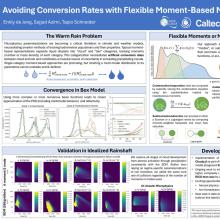Avoiding Conversion Rates with Flexible Moment-Based Microphysics
Emily
de Jong
LLNL
Poster
Modern climate models represent warm-phase hydrometeors by separating liquid droplets into cloud and rain categories and tracking one, two, or three statistical moments of their distributions. Such schemes require parameterizations to represent rates of conversion of cloud droplets into rain droplets, replacing a physically interpretable process (growth by coalescence based on droplet sizes) with artificial rates of autoconversion and accretion. This work presents an alternative moment-based approach in which an arbitrary number of subdistributions may be used to represent the overall droplet size spectrum, including cloud and rain and with potential for extension to aerosol and mixed-phase microphysics. Transfer of moments between these subdistributions is computed from explicit integration over pairs of subdistributions using the same rates of droplet coalescence as the superdroplet or bin methods. This method eliminates the need for conversion rates while also avoiding issues of non-uniqueness when converting between moments and parameters of a multimodal distribution. We demonstrate the accuracy of this approach in modeling rain initiation in both an idealized one-dimensional cloud and a preliminary large eddy simulation. We further demonstrate and discuss the advantages and disadvantages of this approach in the context of parameter calibration.

de-Jong-Emily-poster.pdf
(642.92 KB)
Meeting homepage
